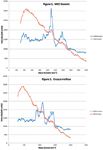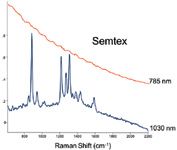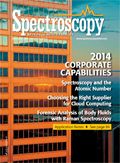Analyzing Highly Fluorescing Cellulose-Based Excipients and Other Complex Molecules with a Novel 1030 nm Handheld Raman Analyzer
Handheld Raman analyzers have found widespread use in the pharmaceutical industry for excipients and raw materials verification, and in first responder/security applications. Most portable Raman units utilize lasers operating at 785 nm because of the relatively good signal strength at this wavelength.
Handheld Raman analyzers have found widespread use in the pharmaceutical industry for excipients and raw materials verification, and in first responder/security applications. Most portable Raman units utilize lasers operating at 785 nm because of the relatively good signal strength at this wavelength.
There are many compounds that fluorescence strongly at 785 nm, causing a featureless background spectrum that obscures the telltale Raman signature. Compounds include the micro-crystalline cellulose (MCC) compounds used as excipients, and nutrients like Folic acid (vitamin B9). For security applications, Semtex and TNT precursors are good examples.

Figure 1, 2: Raman spectra for material MCC Generic (top) and Croscarmellose (bottom) comparing a 785 nm laser and a 1030 nm laser. The Raman peak structure in both compounds is only evident when utilizing the 1030 nm laser.
SciAps has introduced a handheld Raman analyzer utilizing a novel 1030 nm laser source – SWIR Raman. The 1030 nm laser yields reduced fluorescence compared to 785 nm lasers. The 1030 nm laser is compatible with a proprietary Type III-IV sensor that requires less cooling than analyzers using 1064 nm laser sources. There are no cooling fans required, and smaller batteries may be used. Therefore a 1030 nm system is very portable, and is sealed to IP67 standards, making it dunkable and washable for quarantine or hotzone use.

Figure 3: Raman spectrum from a common plastic explosive Semtex. The characteristic Raman peak structure is only evident when using the 1030 nm laser compared to the 785 nm.
One Example: MCC Generic and Croscarmellose
MCC is a particularly good example. MCC can be modified to different degrees of crystalinity usually in the range of 40 to 60%. Raman spectra from MCC generic and Croscarmellose, using the 785 nm laser (Inspector 300) and the 1030 nm laser (Inspector 500) are shown in Figures 1 and 2. The Raman peaks of the MCC and Croscarmellose clearly stand out at 1030 nm but are lost in the featureless fluorescence background at 785 nm. A similar benefit is shown for plastic explosive Semtex. Semtex is a combination of PETN and cyclonite (cyclotrimethylenetrinitramine) that contains complex double bonded N, C, and O structures that produce fluorescence at 785 nm laser wavelengths. As shown in Figure 3 this material is easily identified with a 1030 nm laser source.
SciAps, Inc.
2 Constitution Way, Woburn, MA 01801
tel. (339) 927-9455
Website: www.sciaps.com

Thermo Fisher Scientists Highlight the Latest Advances in Process Monitoring with Raman Spectroscopy
April 1st 2025In this exclusive Spectroscopy interview, John Richmond and Tom Dearing of Thermo Fisher Scientific discuss the company’s Raman technology and the latest trends for process monitoring across various applications.
A Seamless Trace Elemental Analysis Prescription for Quality Pharmaceuticals
March 31st 2025Quality assurance and quality control (QA/QC) are essential in pharmaceutical manufacturing to ensure compliance with standards like United States Pharmacopoeia <232> and ICH Q3D, as well as FDA regulations. Reliable and user-friendly testing solutions help QA/QC labs deliver precise trace elemental analyses while meeting throughput demands and data security requirements.